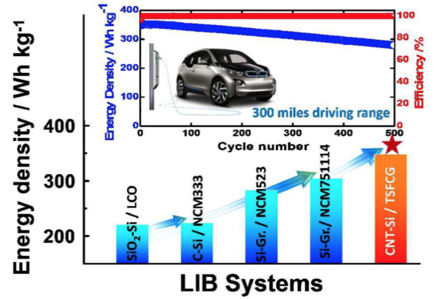ENERGY STORAGE & CONVERSION MATERIALS LAB.
Notice
[2016. 05. 20_Green Car Congress ] Hanyang/BMW team develops high-energy density Li-ion battery

A carbon nanotube (CNT)-Si composite anode with extremely stable long-term cycling provides a discharge capacity of 2364 mAh g-1 at a tap density of 1.1 g cm-3; a two-sloped full concentration gradient (TSFCG) Li[Ni0.85Co0.05Mn0.10]O2cathode, with a Ni-enriched core and Mn-enriched layer, yields a discharge capacity of 221 mAh g-1. The full cell generates an energy density of 350 Wh kg-1with excellent capacity retention for 500 cycles at 1 C rate—satisfying the energy density limit imposed by the drive range requirement for EVs.
Li[Ni0.8Co0.1Mn0.1]O2 (NCM) and Li[Ni0.8Co0.15Al0.05]O2 (NCA) in particular are the most promising candidates for EVs among the next-generation of high energy density cells owing to their high capacity, outstanding rate capability, and low cost. Despite the advantages, increasing the Ni fraction in the NCM cathodes negatively impacts the lifetime and safety of the battery, particularly when higher cut-off voltages and high electrode packing densities are pursued. A number of strategies have been explored to increase the stability of the Ni-enriched NCM cathode material by suppressing the parasitic side reactions with the electrolyte.
Among them, a compositionally graded cathode material in which concentrations of the transition metals continuously varied from the particle center to the surface appears to be the most promising since the graded cathodes have demonstrated remarkable improvements over cathodes with single uniform composition, not only in lifetime and safety, but also in battery power due to the superior Li+ diffusion kinetics. However, like conventional NCM cathodes, it is challenging to increase the Ni concentration above 80% even in the compositionally graded NCM cathodes; hence, a NCM cathode that is compositionally graded with multi-level gradients was introduced in this work to maximize the Ni content near the particle core
Among anode materials for LIB, Si exhibits the highest gravimetric capacity (3579 mAh g-1, when charged to Li15Si4); however, a large volume change during cycling often results in pulverization, electrical contact loss, and constant evolution of the solid-electrolyte interphase (SEI), leading to rapid capacity fading. … The anode strategy proposed in this work is to develop a composite anode consisting of structurally defective Si micro-particles encapsulated by carbon nanotubes, fabricated via the simple ball-milling of nanoporous Si and carbon nanotubes (CNTs).
For the full cell configuration, the researchers added vinylene carbonate (VC) to the electrolyte to aid the formation of a stable SEI layer on the CNT-Si anode for long term cycling.
Green Car Congress : https://www.greencarcongress.com/2016/05/20160520-bmw.h








